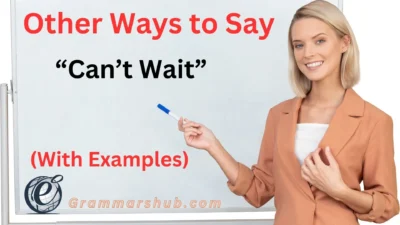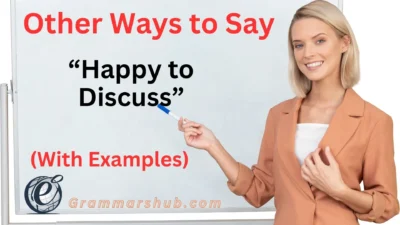Finding the right words to express care and agreement can be challenging, yet it’s one of the simplest ways to make communication feel more personal and meaningful. “Sounds good” is a common phrase, but depending on the situation, it might be more impactful to use alternatives that reflect warmth, understanding, and thoughtfulness. Whether you’re in a professional setting or chatting with friends, expressing yourself clearly and with sincerity can create stronger connections.
What Does “Sounds Good” Mean?
“Sounds good” is a casual and positive response, often used to express agreement or approval. It can also indicate that something seems appealing or acceptable. In most cases, it’s an informal way to say, “I agree” or “That works for me.”
Is It Professional/Polite to Say “Sounds Good”?
While “sounds good” is friendly and casual, it may not always be the most professional choice. In formal settings, you may want to opt for alternatives that sound more polished, such as “I look forward to it” or “That works for me.” Using more neutral language can help convey respect and professionalism, depending on the situation.
Advantages and Disadvantages
Advantages:
- Simple and easy to understand.
- Expresses approval in a friendly, informal manner.
- Can be used in a variety of situations.
Disadvantages:
- May sound too casual for formal settings.
- Overused, and might lack depth or nuance.
Synonyms for “Sounds Good”
- That Works for Me
- I’m On Board
- Sounds Like a Plan
- I’m All In
- Perfect
- Great Choice
- I’m Game
- I Can Get Behind That
- I’m Down
- That Works
- I’m In
- That’s Fine
- Absolutely
- I’m Happy With That
- I Like That Idea
- That Works Perfectly
- I’m Okay With That
- Sure Thing
- I’m Good with That
- That Sounds Like a Great Idea
- Count Me In
- Looks Good to Me
- I’m Open to That
- I Have No Objections
- That’s Fine by Me
- Sounds Great
- I’m Up for That
- That’s a Great Plan
- I’m Happy to Go Along With That
- I’m Fine with That
1. That Works for Me
Meaning: A way of expressing agreement or approval.
Definition: This phrase indicates that something is acceptable or agreeable to you.
Detailed Explanation: You might use this when you’re on board with someone’s idea or plan.
Scenario Example:
Person 1: “How about we meet at 2 p.m. tomorrow?”
Person 2: “That works for me.”
Best Use: Great for both casual and slightly more formal contexts.
Tone: Neutral to friendly.
2. I’m On Board
Meaning: Indicates full support or agreement with an idea or plan.
Definition: This shows that you are enthusiastic or ready to go along with something.
Detailed Explanation: It implies a more proactive stance of joining or supporting the plan.
Scenario Example:
Person 1: “We need to finalize this project by Friday.”
Person 2: “I’m on board.”
Best Use: Good for collaborative or team environments.
Tone: Supportive and active.
3. Sounds Like a Plan
Meaning: A casual way of agreeing with a proposal or idea.
Definition: Similar to saying, “That’s a good idea.”
Detailed Explanation: Often used when you’re happy with a suggestion or arrangement.
Scenario Example:
Person 1: “Let’s grab lunch at noon.”
Person 2: “Sounds like a plan!”
Best Use: Best for casual conversations with friends or colleagues.
Tone: Friendly and upbeat.
4. I’m All In
Meaning: Fully committed or in agreement with something.
Definition: Shows enthusiasm and strong support for a proposal.
Detailed Explanation: A slightly more enthusiastic version of agreeing. It shows you are willing to participate fully.
Scenario Example:
Person 1: “We should start a book club.”
Person 2: “I’m all in!”
Best Use: Great for team projects or when you’re excited about a plan.
Tone: Enthusiastic and positive.
5. Perfect
Meaning: A simple, direct way to show that something is satisfactory or ideal.
Definition: A quick, confident affirmation that the idea or plan is agreeable.
Detailed Explanation: It’s used when something meets your expectations or is seen as flawless.
Scenario Example:
Person 1: “I’ll send you the files by the end of the day.”
Person 2: “Perfect.”
Best Use: Best used in professional or everyday situations.
Tone: Positive and confident.
6. Great Choice
Meaning: A way to acknowledge that a suggestion or decision is a good one.
Definition: Expresses approval of someone’s decision or idea.
Detailed Explanation: This phrase can show admiration for the decision-making process or the choice itself.
Scenario Example:
Person 1: “I think we should go with option A.”
Person 2: “Great choice.”
Best Use: Used when showing approval of a suggestion, especially in decision-making scenarios.
Tone: Supportive and appreciative.
7. I’m Game
Meaning: A casual and enthusiastic way to show you are willing or interested in something.
Definition: Indicates that you’re open to participating or trying something new.
Detailed Explanation: It’s often used when you’re ready to join in or take part.
Scenario Example:
Person 1: “Let’s play a board game tonight.”
Person 2: “I’m game!”
Best Use: Great for informal settings with friends or close colleagues.
Tone: Fun and eager.
8. I Can Get Behind That
Meaning: To show that you support or approve of something.
Definition: You’re expressing alignment with an idea or plan.
Detailed Explanation: This phrase shows that you’re in agreement and support, often used in discussions.
Scenario Example:
Person 1: “Let’s focus on these three areas for the project.”
Person 2: “I can get behind that.”
Best Use: Ideal for discussions about plans or strategies.
Tone: Supportive and considerate.
9. I’m Down
Meaning: Casual way of saying you’re interested or in agreement.
Definition: Used mostly in informal situations, expressing willingness.
Detailed Explanation: It’s often used with friends, indicating that you’re eager to join in.
Scenario Example:
Person 1: “Let’s grab drinks after work.”
Person 2: “I’m down.”
Best Use: Best for informal, friendly situations.
Tone: Casual and enthusiastic.
10. That Works
Meaning: A simple and neutral way to agree with a suggestion.
Definition: Indicates that a proposed plan or idea is acceptable to you.
Detailed Explanation: It’s a straightforward affirmation without adding much enthusiasm.
Scenario Example:
Person 1: “How about we meet on Thursday?”
Person 2: “That works.”
Best Use: Neutral and professional, suitable for most settings.
Tone: Neutral to polite.
11. I’m In
Meaning: Another casual expression to show you’re agreeing to join or participate.
Definition: Used to express your willingness or excitement about being part of something.
Detailed Explanation: It’s an informal way of expressing that you’re on board with an idea or plan.
Scenario Example:
Person 1: “Do you want to join us for the weekend hike?”
Person 2: “I’m in!”
Best Use: Ideal for informal settings, especially among friends or colleagues.
Tone: Enthusiastic and friendly.
12. That’s Fine
Meaning: A polite and neutral way of agreeing.
Definition: Indicates that something is acceptable, but without showing a lot of excitement.
Detailed Explanation: This phrase works well when you don’t have strong feelings about the plan, but it’s agreeable to you.
Scenario Example:
Person 1: “We could meet at 4 p.m. instead of 3.”
Person 2: “That’s fine.”
Best Use: Appropriate in both formal and informal settings where you don’t have a strong preference.
Tone: Neutral, polite.
13. Absolutely
Meaning: A firm, enthusiastic agreement.
Definition: Shows strong support or enthusiasm for the suggestion or idea.
Detailed Explanation: This phrase is commonly used to convey excitement or a strong yes.
Scenario Example:
Person 1: “Would you like to join us for dinner?”
Person 2: “Absolutely!”
Best Use: Works well when you’re eager or highly supportive of a suggestion.
Tone: Enthusiastic and confident.
14. I’m Happy With That
Meaning: Expresses satisfaction with the proposal.
Definition: Indicates that you are pleased and satisfied with the suggestion.
Detailed Explanation: This phrase shows approval in a positive but not overly enthusiastic way.
Scenario Example:
Person 1: “How about we meet at 10 a.m. instead of noon?”
Person 2: “I’m happy with that.”
Best Use: Good for polite, professional settings.
Tone: Polite and agreeable.
15. I Like That Idea
Meaning: A direct way of showing approval of a suggestion.
Definition: This phrase is used to express that you find the idea appealing or attractive.
Detailed Explanation: Often used when you feel positive about a specific suggestion or proposal.
Scenario Example:
Person 1: “What if we organize a team-building event next month?”
Person 2: “I like that idea!”
Best Use: Great for brainstorming sessions or discussions.
Tone: Supportive and engaging.
16. That’s Works Perfectly
Meaning: Indicates that the plan or suggestion fits perfectly with what you were expecting or needing.
Definition: A combination of agreement and satisfaction, showing the plan is ideal.
Detailed Explanation: This phrase implies that everything is in place and that there’s no need for further adjustment.
Scenario Example:
Person 1: “We can meet tomorrow at 2 p.m.”
Person 2: “That works perfectly.”
Best Use: Suitable for both casual and professional settings.
Tone: Confident and positive.
17. I’m Okay With That
Meaning: A polite way of saying that something is acceptable to you.
Definition: Similar to saying “that works for me,” but with a slightly more reserved tone.
Detailed Explanation: It’s a neutral affirmation indicating no issues with the suggestion.
Scenario Example:
Person 1: “We can change the meeting to 1 p.m.”
Person 2: “I’m okay with that.”
Best Use: Neutral, polite—ideal when you don’t want to seem overly enthusiastic.
Tone: Reserved but agreeable.
18. Sure Thing
Meaning: A casual, friendly way to say yes.
Definition: A lighthearted affirmation that something is fine with you.
Detailed Explanation: This is a more informal response, used when you’re happy to go along with something.
Scenario Example:
Person 1: “Are you coming to the party tonight?”
Person 2: “Sure thing!”
Best Use: Best for informal settings or casual conversations.
Tone: Casual, upbeat.
19. I’m Good with That
Meaning: A simple expression of agreement or approval.
Definition: Indicates that you’re satisfied with the proposed plan or idea.
Detailed Explanation: It’s slightly more relaxed than “that works for me” and can convey a sense of ease.
Scenario Example:
Person 1: “We’ll handle it this way for the project.”
Person 2: “I’m good with that.”
Best Use: Ideal for informal conversations or when you want to keep things light.
Tone: Relaxed, agreeable.
20. That Sounds Like a Great Idea
Meaning: An enthusiastic and thoughtful way to express approval.
Definition: It conveys a sense of excitement or appreciation for an idea.
Detailed Explanation: Shows that you find the idea especially appealing or exciting.
Scenario Example:
Person 1: “What do you think about organizing a picnic?”
Person 2: “That sounds like a great idea!”
Best Use: Great for both casual and slightly more formal settings.
Tone: Warm, enthusiastic.
21. Count Me In
Meaning: An enthusiastic way of indicating you’re ready to join or participate.
Definition: This phrase shows eagerness and commitment to being involved.
Detailed Explanation: It’s often used to express that you’re willing to take part in an activity or plan.
Scenario Example:
Person 1: “We’re organizing a team lunch this Friday, are you in?”
Person 2: “Count me in!”
Best Use: Perfect for social or team-based activities, showing that you’re ready and willing.
Tone: Enthusiastic, committed.
22. Looks Good to Me
Meaning: A way of agreeing with something, implying it’s satisfactory or acceptable.
Definition: This is a more casual way of showing that you’re happy with the proposal.
Detailed Explanation: It’s often used when you’re content with the situation but not overly excited about it.
Scenario Example:
Person 1: “How does 9 a.m. sound for our meeting?”
Person 2: “Looks good to me.”
Best Use: Ideal for neutral, everyday conversations.
Tone: Polite and agreeable.
23. I’m Open to That
Meaning: Indicates you’re receptive or willing to consider the idea.
Definition: Expresses that you are open-minded and willing to go along with the suggestion.
Detailed Explanation: This phrase conveys flexibility and willingness to accept new ideas or plans.
Scenario Example:
Person 1: “How about we try a new approach for the project?”
Person 2: “I’m open to that.”
Best Use: Great for professional settings or when you want to show that you’re flexible.
Tone: Open-minded and neutral.
24. I Have No Objections
Meaning: A formal way to express agreement, often used in professional or serious contexts.
Definition: Indicates that you have no issues with the suggestion or plan.
Detailed Explanation: This phrase is slightly more formal than casual alternatives and shows your approval without enthusiasm.
Scenario Example:
Person 1: “We’re thinking of moving the deadline to next Friday, do you think that will work?”
Person 2: “I have no objections.”
Best Use: Best for formal or professional conversations where you want to be clear and respectful.
Tone: Formal, polite.
25. That’s Fine by Me
Meaning: A polite and neutral way of agreeing with something.
Definition: It shows acceptance without much excitement, simply indicating that you’re fine with the proposal.
Detailed Explanation: This phrase is typically used when you don’t have a strong preference either way but are okay with the plan.
Scenario Example:
Person 1: “Let’s have the meeting on Monday.”
Person 2: “That’s fine by me.”
Best Use: Suitable for both casual and professional settings.
Tone: Neutral and polite.
26. Sounds Great
Meaning: A more enthusiastic version of “sounds good,” conveying a bit more excitement.
Definition: It shows a positive response, indicating that the suggestion or plan is very agreeable to you.
Detailed Explanation: It’s a more upbeat and positive way of affirming something, often used in more casual or friendly situations.
Scenario Example:
Person 1: “I’ve booked our tickets for the concert next week!”
Person 2: “Sounds great!”
Best Use: Perfect for social or casual scenarios where you want to show excitement.
Tone: Positive, enthusiastic.
27. I’m Up for That
Meaning: A friendly, informal way of agreeing to a suggestion.
Definition: It conveys that you’re willing to participate or that you’re enthusiastic about the idea.
Detailed Explanation: Often used when you want to indicate that you’re excited about an activity or proposal.
Scenario Example:
Person 1: “Let’s go for a hike this weekend!”
Person 2: “I’m up for that.”
Best Use: Great for casual and social settings.
Tone: Eager, informal.
28. That’s a Great Plan
Meaning: A positive affirmation showing approval for a proposed plan or idea.
Definition: Indicates that the plan or idea sounds well thought out and appealing to you.
Detailed Explanation: This phrase is often used to show that you find the plan logical and agreeable.
Scenario Example:
Person 1: “Let’s meet at the café at noon, then head to the museum.”
Person 2: “That’s a great plan!”
Best Use: Best for both casual and professional settings when you want to compliment the idea.
Tone: Positive and appreciative.
29. I’m Happy to Go Along With That
Meaning: A polite way of expressing your willingness to accept or support an idea.
Definition: It shows a positive and cooperative attitude towards a proposal.
Detailed Explanation: This phrase conveys that you are comfortable with the suggestion and willing to follow through.
Scenario Example:
Person 1: “We could reschedule the meeting for 3 p.m.”
Person 2: “I’m happy to go along with that.”
Best Use: Ideal for professional or group settings when cooperation is key.
Tone: Cooperative, agreeable.
30. I’m Fine with That
Meaning: A simple, neutral way to express acceptance.
Definition: Indicates that you are comfortable with the plan or suggestion and have no issues with it.
Detailed Explanation: It’s often used when you’re content with the situation but not necessarily excited.
Scenario Example:
Person 1: “Do you mind if we move the meeting to next week?”
Person 2: “I’m fine with that.”
Best Use: Best for neutral or professional situations where you want to express acceptance without enthusiasm.
Tone: Neutral, agreeable.
Conclusion
The phrases you use to express agreement can significantly shape your conversations. Whether you’re looking to add warmth to a casual chat or maintain professionalism in a work setting, each of these alternatives to “sounds good” offers a unique way to communicate. By choosing the right phrase for the context, you can make your messages feel more genuine, thoughtful, and engaging.




